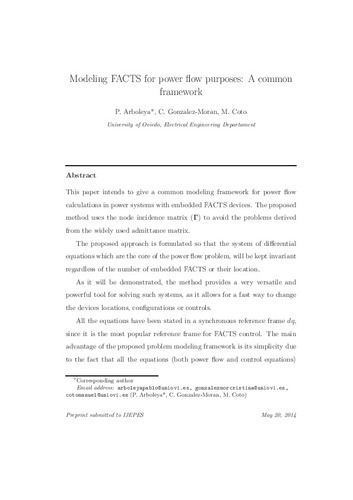Modeling FACTS for power flow purposes: A common framework
Autor(es) y otros:
Palabra(s) clave:
Graph theory
Optimal power flow
Steady-state modeling
Fecha de publicación:
Editorial:
Elsevier
Versión del editor:
Citación:
Descripción física:
Resumen:
This paper intends to give a common modeling framework for power flow calculations in power systems with embedded FACTS devices. The proposed method uses the node incidence matrix (Γ) to avoid the problems derived from the widely used admittance matrix. The proposed approach is formulated so that the system of differential equations which are the core of the power flow problem, will be kept invariant regardless of the number of embedded FACTS or their location. As it will be demonstrated, the method provides a very versatile and powerful tool for solving such systems, as it allows for a fast way to change the devices locations, configurations or controls. All the equations have been stated in a synchronous reference frame dq, since it is the most popular reference frame for FACTS control. The main advantage of the proposed problem modeling framework is its simplicity due to the fact that all the equations (both power flow and control equations) are defined in a unique reference. It has to be remarked that what it is proposed in this work, is a common modeling framework, but not an algorithm or solving procedure. The authors tested the proposed framework with the traditional power flow approach and an Optimum Power Flow (OPF) approach
This paper intends to give a common modeling framework for power flow calculations in power systems with embedded FACTS devices. The proposed method uses the node incidence matrix (Γ) to avoid the problems derived from the widely used admittance matrix. The proposed approach is formulated so that the system of differential equations which are the core of the power flow problem, will be kept invariant regardless of the number of embedded FACTS or their location. As it will be demonstrated, the method provides a very versatile and powerful tool for solving such systems, as it allows for a fast way to change the devices locations, configurations or controls. All the equations have been stated in a synchronous reference frame dq, since it is the most popular reference frame for FACTS control. The main advantage of the proposed problem modeling framework is its simplicity due to the fact that all the equations (both power flow and control equations) are defined in a unique reference. It has to be remarked that what it is proposed in this work, is a common modeling framework, but not an algorithm or solving procedure. The authors tested the proposed framework with the traditional power flow approach and an Optimum Power Flow (OPF) approach
Colecciones
Ficheros en el ítem





